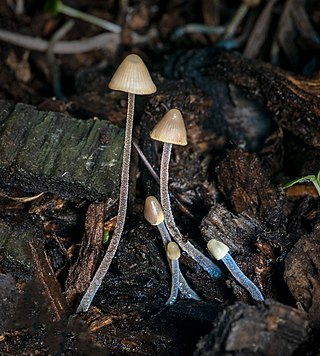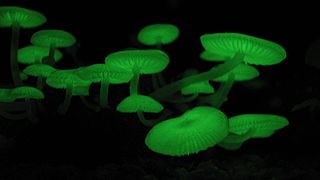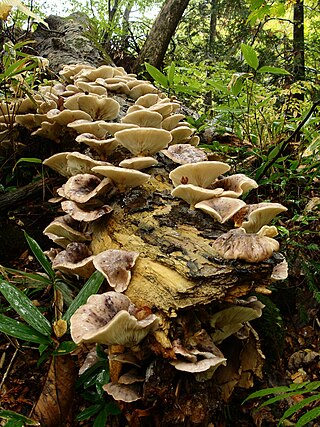Related Research Articles

A mushroom or toadstool is the fleshy, spore-bearing fruiting body of a fungus, typically produced above ground, on soil, or on its food source. Toadstool generally denotes one poisonous to humans.

Mycology is the branch of biology concerned with the study of fungi, including their taxonomy, genetics, biochemical properties, and use by humans. Fungi can be a source of tinder, food, traditional medicine, as well as entheogens, poison, and infection. Mycology branches into the field of phytopathology, the study of plant diseases. The two disciplines are closely related, because the vast majority of plant pathogens are fungi. A biologist specializing in mycology is called a mycologist.

Edible mushrooms are the fleshy fruit bodies of several species of macrofungi. Edibility may be defined by criteria including the absence of poisonous effects on humans and desirable taste and aroma. Mushrooms that have a particularly desirable taste are described as "choice". Edible mushrooms are consumed for their nutritional and culinary value. Mushrooms, especially dried shiitake, are sources of umami flavor.

Bioluminescence is the production and emission of light by living organisms. It is a form of chemiluminescence. Bioluminescence occurs widely in marine vertebrates and invertebrates, as well as in some fungi, microorganisms including some bioluminescent bacteria, and terrestrial arthropods such as fireflies. In some animals, the light is bacteriogenic, produced by symbiotic bacteria such as those from the genus Vibrio; in others, it is autogenic, produced by the animals themselves.

Chemiluminescence is the emission of light (luminescence) as the result of a chemical reaction. There may also be limited emission of heat. Given reactants A and B, with an excited intermediate ◊,

Pleurotus is a genus of gilled mushrooms which includes one of the most widely eaten mushrooms, P. ostreatus. Species of Pleurotus may be called oyster, abalone, or tree mushrooms, and are some of the most commonly cultivated edible mushrooms in the world. Pleurotus fungi have also been used in mycoremediation of pollutants, such as petroleum and polycyclic aromatic hydrocarbons.

Mycena is a large genus of small saprotrophic mushrooms that are rarely more than a few centimeters in width. They are characterized by a white spore print, a small conical or bell-shaped cap, and a thin fragile stem. Most are grey or brown, but a few species have brighter colours. Most have a translucent and striate cap, which rarely has an incurved margin. The gills are attached and usually have cystidia. Some species, like Mycena haematopus, exude a latex when the stem is broken, and many species have a chlorine or radish-like odour.

Omphalotus nidiformis, or ghost fungus, is a gilled basidiomycete mushroom most notable for its bioluminescent properties. It is known to be found primarily in southern Australia and Tasmania, but was reported from India in 2012 and 2018. The fan or funnel shaped fruit bodies are up to 30 cm (12 in) across, with cream-coloured caps overlain with shades of orange, brown, purple, or bluish-black. The white or cream gills run down the length of the stipe, which is up to 8 cm (3 in) long and tapers in thickness to the base. The fungus is both saprotrophic and parasitic, and its fruit bodies are generally found growing in overlapping clusters on a wide variety of dead or dying trees.

Mycena haematopus, commonly known as the bleeding fairy helmet, the burgundydrop bonnet, or the bleeding Mycena, is a species of fungus in the family Mycenaceae, of the order Agaricales. It is widespread and common in Europe and North America, and has also been collected in Japan and Venezuela. It is saprotrophic—meaning that it obtains nutrients by consuming decomposing organic matter—and the fruit bodies appear in small groups or clusters on the decaying logs, trunks, and stumps of deciduous trees, particularly beech. The fungus, first described scientifically in 1799, is classified in the section Lactipedes of the genus Mycena, along with other species that produce a milky or colored latex.
Neonothopanus is a genus of three species of fungi in the agaric family Omphalotaceae. The genus was circumscribed in 1999. The type species N. nambi is found in Australia, South America, Central America, and Malaysia, while N. gardneri is found in South America. Both of these species are bioluminescent. N. hygrophanus, found in central Africa, was added to the genus in 2011.

Panellus stipticus, commonly known as the bitter oyster, the astringent panus, the luminescent panellus, or the stiptic fungus, is a species of fungus in the family Mycenaceae, and the type species of the genus Panellus. A common and widely distributed species, it is found in Asia, Australia, Europe, and North America, where it grows in groups or dense overlapping clusters on the logs, stumps, and trunks of deciduous trees, especially beech, oak, and birch. During the development of the fruit bodies, the mushrooms start out as tiny white knobs, which, over a period of one to three months, develop into fan- or kidney-shaped caps that measure up to 3 cm (1.2 in) broad. The caps are orange-yellow to brownish, and attached to the decaying wood by short stubby stalks that are connected off-center or on the side of the caps. The fungus was given its current scientific name in 1879, but has been known by many names since French mycologist Jean Bulliard first described it as Agaricus stypticus in 1783. Molecular phylogenetic analysis revealed P. stipticus to have a close genetic relationship with members of the genus Mycena.
Neonothopanus gardneri, locally known as flor de coco, is a bioluminescent fungus native to Goiás, Piauí and Tocantins states in Brazil.

Pestalotiopsis microspora is a species of endophytic fungus capable of breaking down and digesting polyurethane. Originally identified in 1880 in fallen foliage of common ivy in Buenos Aires, it also causes leaf spot in Hypericum 'Hidcote' shrubs in Japan.

Mycena chlorophos is a species of agaric fungus in the family Mycenaceae. First described in 1860, the fungus is found in subtropical Asia, including India, Japan, Taiwan, Polynesia, Indonesia, and Sri Lanka, in Australia, and Brazil. Fruit bodies (mushrooms) have pale brownish-grey sticky caps up to 30 mm (1.2 in) in diameter atop stems 6–30 mm (0.2–1.2 in) long and up to a millimeter thick. The mushrooms are bioluminescent and emit a pale green light. Fruiting occurs in forests on fallen woody debris such as dead twigs, branches, and logs. The fungus can be made to grow and fruit in laboratory conditions, and the growth conditions affecting bioluminescence have been investigated.

Omphalotus japonicus, commonly known as the tsukiyotake(月夜茸), is an orange to brown-colored gilled mushroom native to Japan and Eastern Asia. It is a member of the cosmopolitan genus Omphalotus, the members of which have bioluminescent fruit bodies which glow in darkness. A 2004 molecular study shows it to be most closely related to a clade composed of Omphalotus nidiformis of Australia, Omphalotus olivascens of Western North America and Omphalotus olearius of Europe.

Amanita ananiceps is a species of agaric fungus in the family Amanitaceae native to Australia.
Lentinula guarapiensis is a species of agaric fungus in the family Omphalotaceae that is found in Paraguay. Originally described by Carlos Luigi Spegazzini in 1883 as Agaricus guarapiensis, it was moved to the genus Lentinula by David Pegler in 1983. It is only known from the type collection.

Hypsizygus ulmarius, also known as the elm oyster mushroom, and less commonly as the elm leech, elm Pleurotus, is an edible fungus. It has often been confused with oyster mushrooms in the Pleurotus genus but can be differentiated easily as the gills are either not decurrent or not deeply decurrent. While not quite as common as true oyster mushrooms, they have a wide range globally in temperate forests. The mushrooms and vegetative hyphae of this species have been studied in recent years for their potential benefits to human health, and mycoremediation.

Pleurotus albidus is a species of edible fungus in the family Pleurotaceae. Found in Caribbean, Central America and South America, it was described as new to science by Miles Joseph Berkeley, and given its current name by David Norman Pegler in 1983. It grows on trees such as Salix humboldtiana, other willows, Populus and Araucaria angustifolia, and can be cultivated by humans. Phylogenetic research has shown that while it belongs to P. ostreatus clade, it forms its own intersterility group.
References
- ↑ Hahon, N; Castranova, V (1989). "Interferon production in rat type II pneumocytes and alveolar macrophages". Exp Lung Res. 15 (3): 429–45. doi:10.3109/01902148909087869. PMID 2472956.
- ↑ Kanokmedhakul, Somdej; Lekphrom, Ratsami; Kanokmedhakul, Kwanjai; Hahnvajanawong, Chariya; Bua-Art, Sureeporn; Saksirirat, Weerasak; Prabpai, Samran; Kongsaeree, Palangpon (2012). "Cytotoxic sesquiterpenes from luminescent mushroom Neonothopanus nambi". Tetrahedron. 68 (39): 8261–8266. doi:10.1016/j.tet.2012.07.057.
- ↑ Strack, Rita (February 2019). "Harnessing fungal bioluminescence". Nature Methods (Paper). Springer Nature. 16: 140. doi: 10.1038/s41592-019-0311-4 .(subscription required)
- ↑ Mitiouchkina, Tatiana; Mishin, Alexander S.; Somermeyer, Louisa Gonzalez; Markina, Nadezhda M.; Chepurnyh, Tatiana V.; Guglya, Elena B.; Karataeva, Tatiana A.; Palkina, Kseniia; Shakhova, Ekaterina S; Fakhranurova, Liliia I.; Chekova, Sofia V.; Tsarkova, Aleksandra S.; Golubev, Yaroslav V.; Negrebetsky, Vadim V.; Dolgushin, Sergey A; Shalaev, Pavel V.; Shlykov, Dmitry V; Melnik, Olesya A.; Shipunova, Victoria O.; Deyev, Sergey M.; Bubyrev, Andrey I.; Pushin, Alexander S.; Choob, Vladimir V.; Colgov, Sergey V.; Kondrashov, Fyodor A.; Yampolsky, Ilia V.; Sarkisyan, Karen S. (April 2020). "Plants with genetically encoded autoluminescence". Nature Biotechnology. doi:10.1038/s41587-020-0500-9. PMC 7610436 .
- ↑ Spegazzini, Carlos Luigi (1883). "Agaricus nambi". Anales de la Sociedad Científica Argentina (in Latin). 16 (5): 247.
Ad truncos in sylvis subvirgineis prope Guarapí
[On the trunks in the virgin forests near Guarapí] - ↑ Spegazzini, Carlos Luigi (1883). "Agaricus nambi". Anales de la Sociedad Científica Argentina (in Latin). 16 (5): 242.
pulchram collectionem mycologicam Reipublicae Paraguayensis
[the beautiful mycological collection of the Republic of Paraguay] - ↑ Saccardo, Pier Andrea (1887). Sylloge fungorum omnium hucusque cognitorum. Vol. 5. sumptibus auctoris. p. 372.
- ↑ Petersen, Ronald H.; Krisai-Greilhuber, Irmgard (1999). "Type specimen studies in Pleurotus". Persoonia. 17 (2): 201–19.